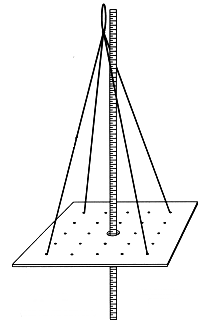|
Arriving at exact lb/acre or kg/ha is impossible and
unnecessary.
What we really need is a good estimate to plan the
maintence of the grazing wedge and to help us decide whether
to graze the cows in a paddock today, next week, split it
up, or to save the paddock for silage.
If we are, let's say, 20% off in our estimates, it isn't
of major importance. So long as we are consistent in our
measurements and calculations, we will probably always be
off in about the same way and can learn to compensate.
Of course, it will be much easier to compensate if the
estimate is over rather then under!
The five New Zealand Formulas for estimating dry
matter:
I don't know for certain that I have these quoted
correctly, nor do I know how widely accepted they are in New
Zealand.
|
|
Season
|
Formula
|
|
1
|
Winter and early Spring
(before stem growth)
|
height in centimeters x 125 + 640 = kg/ha
|
|
2
|
Late Spring and early Summer
(during stem growth)
|
cm x 130 + 990 = kg/ha
|
|
3
|
Mid Summer
|
cm x 165 + 1480 = kg/ha
|
|
4
|
Early Autumn
(before autumn rains)
|
cm x 159 + 1180 = kg/ha
|
|
5
|
Late Autumn
(after rain)
|
cm x 157 + 970 = kg/ha
|
The US Semi-Standard Fromula for estimating dry
matter:
This formula is not accepted by everyone but is the best
guide currently available.
|
Season
|
Formula
|
|
All seasons
|
1 inch = 432 lb/acre
|
Why does it matter?
First some background:
There are two kinds of dairy farmers doing Intensive Grazing
in the United States:
(1) Those making real progress
(2) and those that are just "spinning their wheels".
The simplest way to draw the line between these two
groups is with the Grazing Wedge
Concept.
If a dairy farmer establishs and maintains a grazing
wedge, then most likely that fellow is making
progress.
If he grazes but ignores the grazing wedge concept or
doesn't even know what it is, then that fellow is probably
just "running in place".
It is essential to estimate the amount of grass in
the paddock in order to establish and maintain a grazing
wedge.
 One way to estimate the amount of grass is with
a Rising Plate Meter. One way to estimate the amount of grass is with
a Rising Plate Meter.
But a Rising Plate Meter measures inches of height (as
depressed by the weight of the plate).
The height in inches must be converted to pounds of dry
matter per acre or lb/acre or kg/ha.
A grass researcher would clip a bunch of representative
samples, dry them, and weigh them.
Most farmers aren't able to do that, but they can use a
formula to convert the inches to estimated lbs/acre.
An example formula is: 1 inch of height (depressed) = 432
lbs / acre
[Table of Contents]
[Top]
[fwo@ bright.net]
| 
 One way to estimate the amount of grass is with
a Rising Plate Meter.
One way to estimate the amount of grass is with
a Rising Plate Meter.